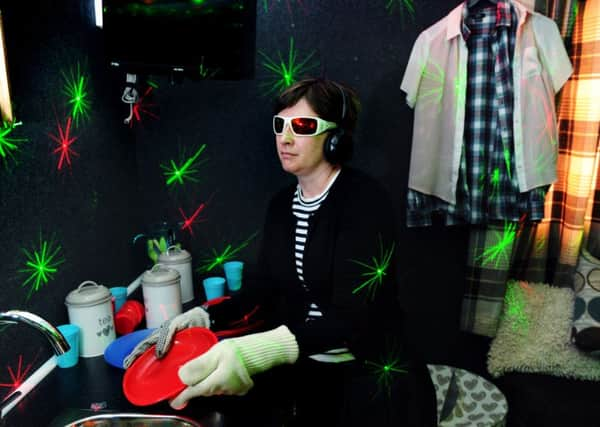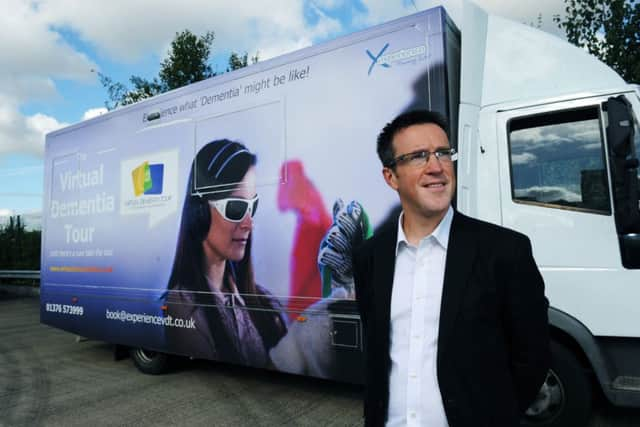Too painful to walk, too noisy to hear and nothing to see - so this is what dementia really feels like


The pins and needles are constant and painful, vision is reduced to virtually nothing and the volume on the background noise has been turned up. Occasionally I glimpse something which looks vaguely familiar, a pair of glasses or a cushion perhaps, but for the most part this is a strange, intimidating world. It’s also pretty much what every sufferer of mid-stage dementia feels like 24-7.
The Virtual Dementia Experience - yes, it sounds like a ride at a particularly macabre fairground - was developed in America by geriatric specialist PK Beville after she became frustrated with the lack of empathy shown to those with dementia. Based on the philosophy that walking in someone’s shoes for a few minutes is more enlightening than a hundred academic papers, Beville set out to recreate the main symptoms of dementia from sensory deprivation to mobility issues.
Advertisement
Hide AdAdvertisement
Hide Ad“Every dementia sufferer will display slightly different symptoms, but this is as close as it comes to really feeling like you have the condition,” says Tony Brice, one of the team bringing The Virtual Tour to the UK. “A huge amount of work has been put into ensuring we have got it right. PK consulted closely with those with dementia and went back to the drawing board numerous times to recreate the sounds they hear which we then play through headphones.”


Living with dementia is noisy. Background sounds come to the foreground and everything from a ticking clock to a kitchen radio is amplified to one constant cacophony. Add in the glasses which limit vision, the gloves which make doing up a shirt button impossible and those prickly insoles and it quickly becomes apparent why dementia sufferers are easily frustrated. “Once you get a glimpse of what life is like with dementia, you can start to see why people behave in certain ways,” says Tony. “When you know the noise in their head is constant, you can see why even walking past with a tea trolley which has a squeaky wheel might be distressing.”
Housed in a truck, which travels round the country, The Virtual Dementia Tour arrived in Britain a couple of years ago and the team has been working with various organisations, from the police to local authorities and even a group of nuns. This week it pulled up in the carpark of the LNT Group. The Garforth-based company runs 15 Ideal Carehomes across Yorkshire and it’s keen that both its frontline and backroom staff take part in the experience.
“There is nothing else like this,” says chief executive Matt Lowe as we get kitted out for the tour. This is his first time, but he’s heard good reports from staff who have already been through the experience. “I’ve tried not to ask too many questions as I wanted to come to it fresh, but it’s really interesting how people react. For some it’s incredibly emotional, but everyone I have spoken to has said that while it was difficult it was also really rewarding.”
Advertisement
Hide AdAdvertisement
Hide AdThe experience lasts just eight minutes. It feels much longer. Matt later admits that he spent most of his time arranging a pile of spectacles because it was the only corner of the van where he didn’t feel completely disorientated. Others, like me, wander aimlessly, hoping to stumble across something they recognise. When they do they hang onto whatever it is like their life depended on it. Quite a few are unable to cope with the pain in their feet, which replicates the loss of nerve-endings, and just find a quiet corner to sit it out.


When the tap on the shoulder comes to say it’s over, the collective sigh of relief is audible. However, the tour isn’t designed just to make the rest of us feel grateful that the condition has not yet touched us. It is about changing attitudes.
There are currently 850,000 people living with dementia in the UK. That figure is set to rise to more than one million by 2025. By 2051 it will have reached two million and as the condition progresses, each one of them will need to be cared for. While there is no cure, there are a hundred small ways in which life can be made just that little bit easier.
It’s about replacing ticking clocks with ones that don’t tick at all, it’s about understanding that when someone with dementia looks in the mirror they don’t see themselves, they see instead an older relative, their mum or dad perhaps, or worse someone from their past they would rather forget
Advertisement
Hide AdAdvertisement
Hide AdThere are other things too. Red is one of the first colours we see and it’s the last to go. That means it is a good colour for crockery and cutlery and as a border to identify light switches.


“Not all of this advice will work for every person suffering from dementia, but as long as we are trying to give people a better quality of life, that’s the important thing,” says Tony. “It’s about understanding what might be causing certain behaviour. If someone doesn’t eat their breakfast it may be that they are not hungry, but it also maybe because they can’t see the beige porridge in a beige bowl or that they were waiting to be given permission to eat.
“One of the key things to remember is that someone living with dementia might remember exactly what they were doing 50 or 60 years ago, but have no idea what happened a few moments ago. It’s why you should always introduce yourself every time you speak to them, just so that they know who you are. It takes just a few seconds and it might just prevent them lashing out at someone they see as a stranger.”
As dementia progresses, sufferers become both increasingly isolated and less active and there are care homes where some residents rarely leave their chairs.
Advertisement
Hide AdAdvertisement
Hide Ad“We had some good results in one home where we gave each of the residents a pair of Reebok trainers to wear,” adds Tony. “They were far more cushioned than their usual footwear and while it didn’t take away the pain in their entirely, it did mean that they could be more active. Not everyone can afford to hand out new trainers, but you can get the same result with a cheap piece of memory foam.


“We have to remember that everyone who has dementia is a person in their own right. They once had a job, brought up a family and were once just like us. As the condition takes hold, their sense of self-worth plummets. You will often see someone with dementia wandering around looking for something worthwhile to do and we have to try engaging with them. If they do their shirt up and it’s a few buttons out leave it. That’s far better than telling them they have got it wrong.”
Each tour is followed by an hour long debrief, where those taking part are encourage to chat about how it felt to be a prisoner of their own body.
“These things are always pretty humbling,” says Matt. “We have already done a lot of what Tony suggested in our homes, but there is always more we can do. We might not be able to take the dementia away, but we can give them back their dignity.”